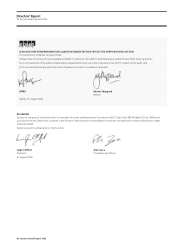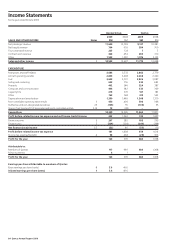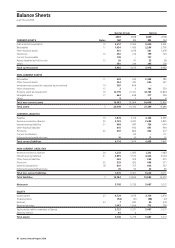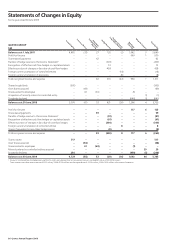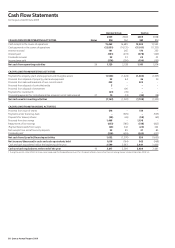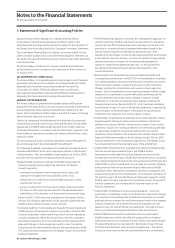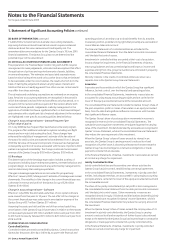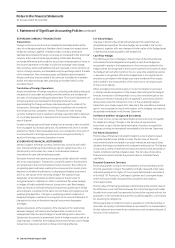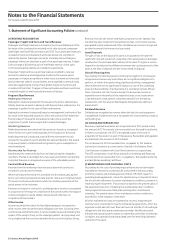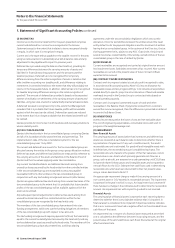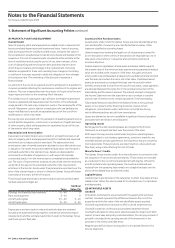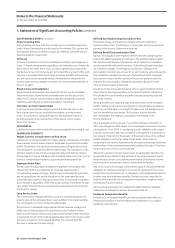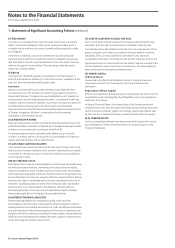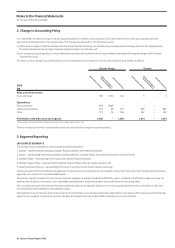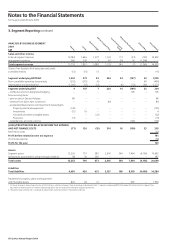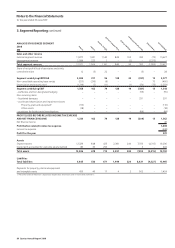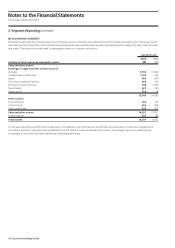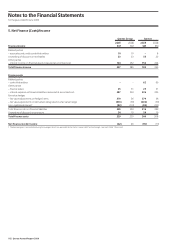Qantas 2009 Annual Report Download - page 95
Download and view the complete annual report
Please find page 95 of the 2009 Qantas annual report below. You can navigate through the pages in the report by either clicking on the pages listed below, or by using the keyword search tool below to find specific information within the annual report.
93 Qantas Annual Report 2009
Notes to the Financial Statements
for the year ended 30 June 2009
1. Statement of Significant Accounting Policies continued
(J) INCOME TAX
Income tax on the Income Statement for the years presented comprises
current and deferred tax. Income tax is recognised in the Income
Statement except to the extent that it relates to items recognised directly
in equity, in which case it is recognised in equity.
Current tax is the expected tax payable on the taxable income for the year,
using tax rates enacted or substantially enacted at balance date and any
adjustment to tax payable with respect to previous years.
Deferred tax is provided using the balance sheet method, providing for
temporary differences between the carrying amounts of assets and
liabilities for financial reporting purposes and the amounts used for
taxation purposes. Deferred tax is not recognised for temporary
differences arising from the initial recognition of assets or liabilities that
affect neither accounting nor taxable profit, and differences relating to
investments in controlled entities to the extent that they will probably not
reverse in the foreseeable future. In addition, deferred tax is not recognised
for taxable temporary differences arising on the initial recognition of
goodwill. The amount of deferred tax provided is based on the expected
manner of realisation or settlement of the carrying amount of assets and
liabilities, using tax rates enacted or substantially enacted at balance date.
A deferred tax asset is recognised only to the extent that Management
considers that it is probable that future taxable profits will be available
against which the asset can be utilised. Deferred tax assets are reduced
to the extent that it is no longer probable that the related tax benefit will
be realised.
Qantas provides for income tax in both Australia and overseas jurisdictions
where a liability exists.
(K) TAX CONSOLIDATION
Qantas is the head entity in the tax consolidated group comprising Qantas
and all of its Australian wholly-owned entities and partnerships. The
implementation date of the tax consolidation system for the tax
consolidated group was 1 July 2003.
The current and deferred tax amounts for the tax consolidated group are
allocated among the entities in the group using a group allocation method.
Deferred tax assets and deferred tax liabilities are measured by reference to
the carrying amounts of the assets and liabilities in the Balance Sheet of
Qantas and their tax values applying under tax consolidation.
Any current tax liabilities/assets and deferred tax assets arising from
unused tax losses assumed by the head entity from the controlled entities
in the tax consolidated group are recognised as amounts payable/
(receivable) to/(from) other entities in the tax consolidated group in
conjunction with any tax funding arrangement amounts (refer below).
Qantas recognises deferred tax assets arising from unused tax losses of the
tax consolidated group to the extent that it is probable that future taxable
profits of the tax consolidated group will be available against which the
asset can be utilised.
Any subsequent period adjustments to deferred tax assets arising from
unused tax losses assumed from controlled entities within the tax
consolidated group are recognised by the head entity only.
The members of the tax consolidated group have entered into a tax
funding arrangement, which sets out the funding obligations of members
of the tax consolidated group with respect to tax amounts.
The tax funding arrangements require payments to/(from) the head entity
equal to the current tax liability/asset assumed by the head entity and any
tax loss deferred tax asset assumed by the head entity. The members of the
tax consolidated group have also entered into a valid tax sharing
agreement under the tax consolidation legislation which sets out the
allocation of income tax liabilities between the entities should the head
entity default on its tax payment obligations and the treatment of entities
leaving the tax consolidated group. In the opinion of the Directors, the tax
sharing agreement limits, subject to any ASIC Class Order, the joint and
several income tax related liability of the wholly-owned entities of the tax
consolidated group in the case of default by Qantas.
(L) RECEIVABLES
Current receivables are recognised and carried at original invoice amount
less impairment losses. Bad debts are written off as incurred. Non-current
receivables are carried at the present value of future net cash inflows
expected to be received.
(M) CONTRACT WORK IN PROGRESS
Contract work in progress is stated at cost plus profit recognised to date,
in accordance with accounting policy Note 1(G), less an allowance for
foreseeable losses and less progress billings. Cost includes all expenditure
related directly to specific projects and an allocation of fixed and variable
overheads incurred in the Qantas Group’s contract activities based on
normal operating capacity.
Contract work in progress is presented as part of trade and other
receivables in the Balance Sheet. If payments received from customers
exceed the income recognised, then the difference is presented as deferred
income in the Balance Sheet.
(N) INVENTORIES
Inventories are measured at the lower of cost and net realisable value.
The cost of engineering expendables, consumable stores and work in
progress is the weighted average cost.
(O) IMPAIRMENT
Non-financial Assets
The carrying amounts of assets (other than inventories and deferred tax
assets) are reviewed at each balance date to determine whether there is
any indication of impairment. If any such conditions exists, the assets’
recoverable amount is estimated. For goodwill and intangible assets with
indefinite lives, the recoverable amount is established each year. The
recoverable amount of assets is the greater of their fair value less costs to
sell and value in use. Assets which primarily generate cash flows as a
group, such as aircraft, are assessed on a cash generating unit (CGU) basis
inclusive of related infrastructure and intangible assets and compared to
net cash flows for the CGU. Estimated net cash flows used in determining
recoverable amounts have been discounted to their net present value,
using a rate as described in Note 17.
An appropriate impairment charge is made if the carrying amount of a
non-current asset or CGU exceeds its recoverable amount. The impairment
is expensed in the year in which it occurs. An impairment loss is reversed if
there has been a change in the estimates used to determine the recoverable
amount. An impairment loss with respect to goodwill is not reversed.
Financial Assets
The carrying value of financial assets is assessed at each reporting date to
determine whether there is any objective evidence that it is impaired. A
financial asset is considered to be impaired if objective evidence indicates
that one or more events have had a negative effect on the estimated future
cash flows of that asset.
An impairment loss in respect of a financial asset measured at amortised
cost is calculated as the difference between its carrying amount, and the
present value of the estimated future cash flows discounted at the original
effective interest rate.


